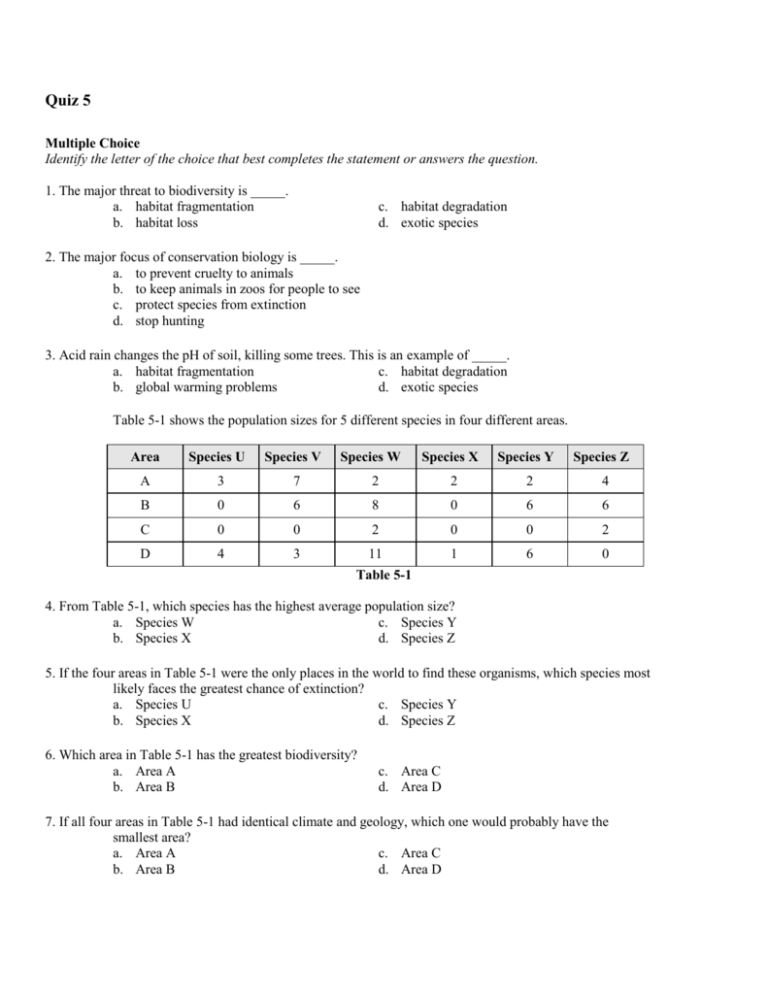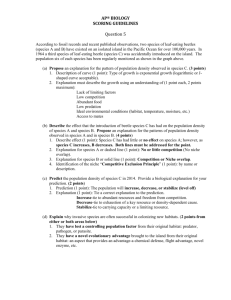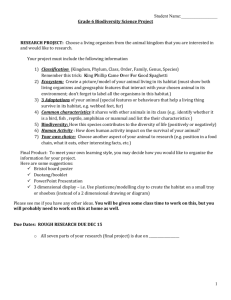Test 5 - West Jefferson Local Schools
advertisement

Quiz 5 Multiple Choice Identify the letter of the choice that best completes the statement or answers the question. 1. The major threat to biodiversity is _____. a. habitat fragmentation b. habitat loss c. habitat degradation d. exotic species 2. The major focus of conservation biology is _____. a. to prevent cruelty to animals b. to keep animals in zoos for people to see c. protect species from extinction d. stop hunting 3. Acid rain changes the pH of soil, killing some trees. This is an example of _____. a. habitat fragmentation c. habitat degradation b. global warming problems d. exotic species Table 5-1 shows the population sizes for 5 different species in four different areas. Area Species U Species V A 3 7 B 0 C D Species W Species X Species Y 2 2 2 4 6 8 0 6 6 0 0 2 0 0 2 4 3 1 6 0 11 Table 5-1 Species Z 4. From Table 5-1, which species has the highest average population size? a. Species W c. Species Y b. Species X d. Species Z 5. If the four areas in Table 5-1 were the only places in the world to find these organisms, which species most likely faces the greatest chance of extinction? a. Species U c. Species Y b. Species X d. Species Z 6. Which area in Table 5-1 has the greatest biodiversity? a. Area A b. Area B c. Area C d. Area D 7. If all four areas in Table 5-1 had identical climate and geology, which one would probably have the smallest area? a. Area A c. Area C b. Area B d. Area D For many years orchid collectors searched Exotic Islands for the beautiful Kimmarie Orchid, which is found no place else in the world. After they found the orchid, they brought it back to their homes. In the last couple of years the Kimmarie Orchid has not been found on the island. As a result, hobbyists are now sending the Kimmarie Orchid to be replanted on the island. 8. The Kimmarie Orchid became extinct in the wild due to _____. a. habitat loss c. habitat degradation b. exotics d. overcollection 9. The hobbyists are trying to correct the Kimmarie Orchid problem they caused by using _____. a. exotic species c. habitat corridors b. a reintroduction program d. habitat fragments 10. Island A has an area of 30 square kilometers. Island B has an area of 400 square kilometers. The islands are near each other. Which of the following statements is most likely to be true? a. Island A has greater biodiversity and a higher percentage of edge effect than Island B. b. Island A has less biodiversity and a higher percentage of edge effect than Island B. c. Island A has greater biodiversity and a lower percentage of edge effect than Island B. d. Island A has less biodiversity and a lower percentage of edge effect than Island B. 11. Consider the following pairs of organisms: large predators and small predators; large herbivores and small herbivores; and migratory animals and non-migratory animals. The two animals most likely to suffer the most from habitat fragmentation are the _____. a. large predators and migratory animals b. large herbivores and large predators c. non-migratory animals and small herbivores d. migratory animals and large herbivores 12. Which one of the following is NOT a cause of acid precipitation? a. sulfur dioxide from burning coal b. nitrogen oxides from car exhaust c. destruction of the ozone layer 13. Carnivorous birds that fed on organisms exposed to this chemical produced fragile eggs. The chemical is _____. a. CFC c. DDT b. DNA d. nitrogen oxide 14. Salvinia molesta, a floating aquatic plant, first entered Lake Naivasha in Kenya when a person's fish ponds flooded. The plant quickly grew with little competition, changing the habitat of parts of the lake. This is most likely an example of a problem due to _____. a. reintroduction programs c. habitat fragmentation b. exotic species d. edge effect 15. Which is NOT true of the U.S. Endangered Species Act? a. It was responsible for the creation of Yellowstone National Park. b. President Nixon signed it into law in 1973. c. It was partially responsible for the recovery of some threatened species. d. Other countries have created similar laws. 16. A conservation biology organization wants to raise money to buy a strip of land to connect Protected Area A to Natural Park Area B. This strip would most likely serve _____. a. as a road for tourists c. to fragment the habitat b. as a wildlife corridor d. to slow ozone destruction 17. When the last member of a species dies, it becomes a. threatened b. endangered c. exotic d. extinct 18. Water and air pollution are examples of _____. a. habitat fragmentation b. habitat degradation c. edge effect d. sustainable use 19. Which country has the fewest species of mammals? a. Canada b. United States c. Mexico 20. If the communities in Figure 5-4 were put in order of least to most biological diversity, they would be _____. Figure 5-4 a. ABCD b. CADB c. DBCA d. BDAC Figure 5-5 21. What does the graph in Figure 5-5 tell you? (An islet is a small island.) a. b. c. d. the farther from land, the more biodiversity the larger the islet, the more biodiversity islet size and biodiversity are not related biodiversity decreases with islet size 22. Using the graph in Figure 5-5, extrapolate what would happen to biodiversity on a large island or continent. a. biodiveristy would increase greatly b. biodiversity would decrease greatly c. biodiveristy would first increase, then decrease d. biodiversity would remain constant 23. Using the information from the graph in Figure 5-5, predict what would happen to biodiversity if the ocean level increased. a. it would increase c. it would decrease b. it would remain the same d. it would disappear Figure 5-6 24. What happened to species B in the graph shown in Figure 5-6? a. it increased in biodiversity c. it became carnivorous b. it decreased in population slightly d. it became extinct 25. What effect did the loss of species B have on species A and D in Figure 5-6? a. it caused the populations of A and D to decrease b. it caused the populations of A and D to increase c. it caused the populations of A and D to become extinct d. it had no effect on the populations of A and D 26. Suggest what happened to species E in Figure 5-6. a. it became extinct b. it replaced species B in its niche Table: Populations and Extinctions Initial No. Island Area (km2) of Species A 850,000 175 B 300,000 140 C 90,000 80 Figure 5-7 c. it stopped eating species B d. it started eating species A Extinctions 25 35 50 27. What factor, according to the data in Figure 5-7, has the greatest impact on species loss? a. the original number of species c. the area of the island b. the distance from the mainland d. the climate 28. Using Figure 5-7, predict what the approximate species loss would be on an island that is 500,000 km2 in size. a. less than 25 c. between 35 and 50 b. between 25 and 35 d. more than 50 29. The amount of biological diversity in an area is called ____________________. a. abiotic factors c. community b. biodiversity d. development 30.____________________ is a branch of biology that focuses on the preservation of biodiversity. a. anatomy c. conservation biology b. ecology d. genetics 31. The number of ____________________ in an area is a measure of biodiversity. a. species c. communities b. biomes d. decomposers 32. The biggest threat to biodiversity is ____________________. a. habitat fragmentation c. habitat degradation b. habitat loss d. habitat rehabilitation 33. Mexico has more biodiversity than the United States because it is _________________________. a. further from the equator c. smaller in size b. larger in size d. closer to the equator 34. Human development often creates small isolated patches of wildlife area. This is known as a. habitat loss c. habitat degradation b. habitat rehabilitation d. habitat fragmentation 35. The actions of zebra mussels and sea lamprey, which were introduced to the Great Lakes from other geographic regions, are examples of problems caused by ____________________ species. a. exotic c. rare b. illegal d. immigrant 36. ____________________ programs seek to establish species in areas where they once lived. a. Elimination c. Reintroduction b. Negligent d. Fragmentation 37. Allowing local people to collect fallen branches from trees in a protected forest is an example of the philosophy of ____________________ use. a. absolute c. preservative b. sustainable d. corrective 38. The U.S. ____________________ Act of 1973 gave legal protection to threatened and endangered species. a. Biodiversity c. Endangered Species b. Animal Abuse d. Threatened Species 39. The use of CFCs can destroy the ____________________ in the upper atmosphere. a. stratosphere c. ozone layer b. greenhouse layer d. magnetosphere 40. A patch of wildlife area may have different climate conditions around its perimeter. This is known as a. edge effect c. acclimatization b. fragmentation effect d. habitat degradation







